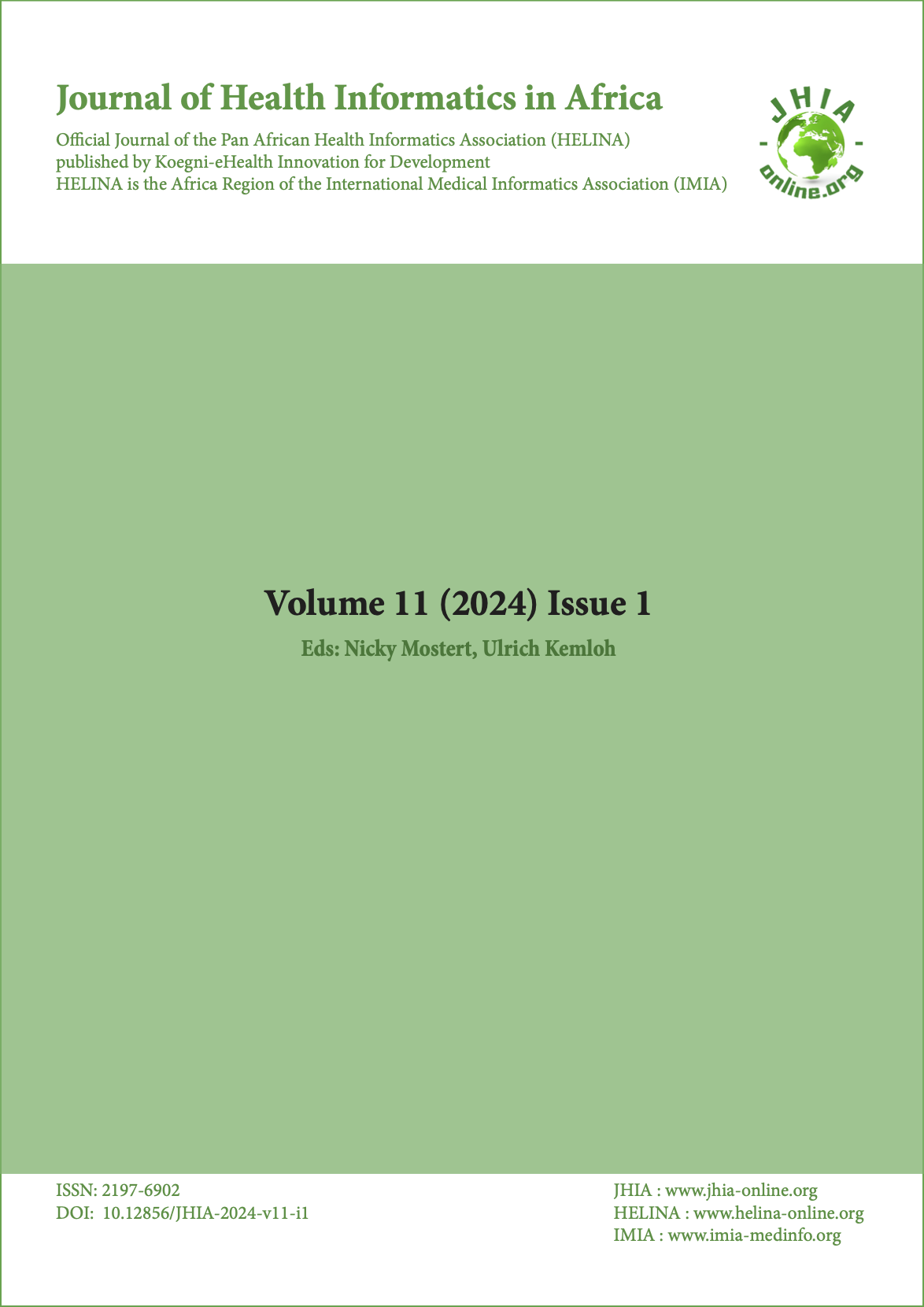« 2arcf Systeme » Un Logiciel A Moindre Cout Pour L’interprétation du Rythme Cardiaque Fœtal
DOI:
https://doi.org/10.12856/JHIA-2024-v11-i1-156Abstract
Contexte : Madagascar, un pays en développement, a des difficultés à acquérir les nouvelles technologies médicales, parmi elles les appareils d’interprétation du rythme cardiaque fœtal (RCF). Notre étude consiste à la création d’un logiciel qui analyse automatiquement le RCF avec les ressources matérielles disponibles et l’évaluation de son efficacité.
Méthode : Le projet informatique s’est fait en deux étapes : la phase de spécifications et la phase de codage du logiciel incluant la phase test. Matrix Laboratory a été utilisé pour la création de ce logiciel.
Pour la phase test, nous avons recruté au hasard des enregistrements du RCF puis analysé le logiciel créé. Une étude prospective descriptive sur ces enregistrements a été menée et pour préciser la fiabilité des résultats du logiciel, nous avons réalisé une étude comparative de ces derniers avec l’analyse conventionnelle se basant sur la classification du RCF du CNGOF.
Résultats : Le logiciel « 2ARCF système » a été créé. Cent dix enregistrements ont été recrutés. Après analyse conventionnelle 40,9% des tracés revenaient normaux contre 61,8% après analyse informatisée avec un coefficient de concordance de kappa à 0,564. La moyenne des écarts entre les valeurs du rythme de base des deux méthodes selon la procédure décrite par Bland et Altman était de 1,249 bpm.
Conclusion : L’application « 2ARCF système » a montré sa fiabilité. Elle est un atout, surtout dans les régions éloignées de Madagascar.
Mots-clés : analyse, logiciel, Madagascar, rythme cardiaque fœtal.
Downloads
References
REFERENCES BIBLIOGRAPHIQUES
- Recommandations pour la pratique clinique du CNGOF : modalités de surveillance fœtale pendant le travail. http://www.cngof.asso.fr/D.TELE/rpc.surv-foet.2007.pdf
- Journois D. Comparaison de deux variables : l'approche graphique (Méthode de Bland et Altman). Rev Mal Respir. 2004; 21: 127-30.
- Hiett AK, Devoe LD, Youssef A, Gardner P, Black M. A comparison of visual and automated methods of analyzing fetal heart rate tests. Am J Obstet Gynecol. 1993; 168: 1517-21.
- Gagnon R, Campbell MK, Hunse C. A comparison between visual and computer analysis of antepartum fetal heart rate tracings. Am J Obstet Gynecol. 1993; 168: 842-7.
- Flynn AM, Kelly J, Matthews K, O'Conor M, Viegas O. Predictive value of, and observer variability in, several ways of reporting antepartum cardiotocograph. Br J Obstet Gynecol. 1982; 89: 434-40.
- Lotgering FK, Wallenburg HCS, Schouten HJA. Interobserver and intraobserver variation in the assessment of antepartum cardiotocogram. Am J Obstet Gynecol. 1992; 144: 701-5.
- Bracero LA, Morgan S, Byrne DW. Comparison of visual and computerized interpretation of nonstress test results in a randomized controlled trial. Am J Obstet Gynecol. 1999; 181: 1254-8.
- Dawes GS, Visser GH, Goodman JD, Levine DH. Numerical analysis of the human fetal heart rate: modulation by breathing and movement. Am J Obstet Gynecol. 1981; 140: 535-44.
- Economides DL, Selinger M, Ferguson J, Bowell PJ, Dawes GS, Mackenzie IZ. Computerized measurement of heart rate variation in fetal anemia caused by rhesus alloimmunization. Am J Obstet Gynecol. 1992; 167: 689-93.
- Ribbert LS, Snijders RJ, Nicolaides KH, Visser GH. Relation of fetal blood gases and data from computer-assisted analysis of fetal heart rate patterns in small for gestation fetuses. Br J Obstet Gynecol. 1991; 98: 820-3.
- Pardey J, Moulden M, Redman CW. A computer system for the numerical analysis of nonstress tests. Am J Obstet Gynecol. 2002; 186: 1095-103.
- Westgate J, Harris M, Curnow JSH, Greene KR. Plymouth randomized trial of cardiotocogram only versus ST weveform plus cardiotocogram for intrapartum monitoring in 2400 cases. Am J Obstet Gynecol. 1993; 169: 1151-60.
- Strachan B, Sahota D, van Wijngaarden WJ, James DK, Chang AZM. The fetal electrocardiogram: relationship with acidemia delivery. Am J Obstet Gynecol. 2000; 182: 603-6.
- Ayres-de-Campos D, Sousa P, Costa A, Bernardes J. Omniview-SisPorto 3.5a central fetal monitoring station with online alerts based on computerised cardiotocogram + ST event analysis. J Perinat Med. 2008; 36:260–4.
- Costa A, Ayres-de-Campos D, Costa F, Santos C, Bernardes J. Prediction of fetal acidemia by computer analysis of fetal heart rate and ST event signals. Am J Obstet Gynecol. 2009; 201(5).464.e1-6.





